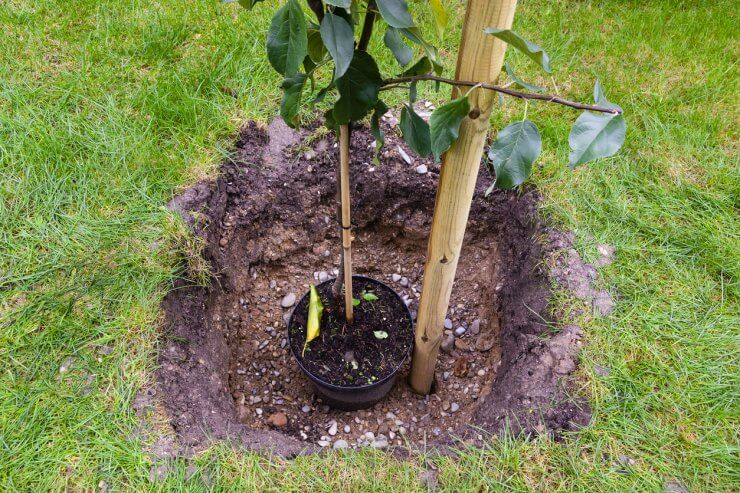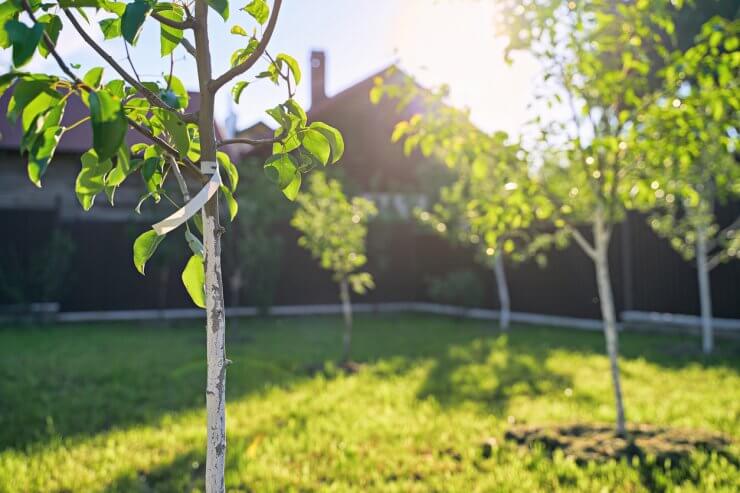
Apple tree ready to be planted in the ground
Apples need lots of sunshine in order to thrive; six to eight hours a day. They also need well-drained soil with a pH of 6.0 to 7.0. You want your soil composition to be in that Goldilocks zone: not too sandy, not to heavy with clay. If your soil isn’t just right, make some adjustments before you prepare to plant your trees.
Acclimation
No one likes to be flung into a new environment with no warning; apple trees are no different. They need a period of acclimation so they can adjust to their new environment before you plant them. The acclimation period helps keep environmental stress to a minimum. Sudden changes in sunlight and temperature can shock your young tree and have an adverse effect on its growth. This is just like hardening off seedlings—except your “seedling” is much bigger.
If your tree comes in a pot, don’t disturb it. Put it in a sheltered, shady spot outdoors, like a porch. Leave it there for a few hours, then bring it inside for overnight. Each day, for the next two to three days, leave the tree outside for an additional hour or two, then bring it inside for the night.
Next, you can move your tree from the shade to a spot that gets some morning sun. Move it back into the shade in the afternoon. If you can’t be there during the day, find a spot that has filtered sunlight throughout the day. Bring the tree in at night.
Check the pot for dryness. Water your tree regularly so the roots don’t dry out. If your indoor environment is especially dry, you can mist the tree’s leaves; that will make for a happy tree.
Check the foliage. If the leaves look injured, put the tree out into filtered sunlight for just a few hours a day. Extend its outdoors time as the leaves look better. After seven to 10 days, your tree should be ready to plant.
Make sure the weather conditions are right. The ideal time to plant your tree is on a cloudy day. This helps the tree ease into its new living space.
One way to check whether your tree agrees with your chosen planting location is to leave it in its nursery container after it’s acclimated, and put it in the spot you have in mind. Keep it well watered. In a week or two, you’ll know if that’s the right spot for your tree.
Planting
It’s best to plant apple trees when they’re dormant; late spring, when the soil is workable, is a good time. You can also plant them in the fall; your local nursery can give you the best planting times for your location. When you’re ready to plant your young tree, gently remove it from the container. Check the root system; cut off any dead or broken roots. Keep the roots out of the sun during this process.
You’ll want to soak your tree’s roots in a bucket of water for an hour or two before you plant it; this helps keep the roots from drying out while you’re digging. Of course, you could dig the hole the day before to have it ready, but a good soak for an hour or two will help make the transition easier on the tree. Just don’t soak it for more than six hours.
Make sure the hole is deep enough that the bud union of the tree—where the rootstock meets the scion—will sit 3 to 4 inches above the soil line. The hole should be wide enough that the tree’s roots aren’t cramped. Take a close look at the roots to see which side of the root system has the most roots. When you plant the tree, plant it so that the side that has the most roots points in the direction of the prevailing winds. This will give the tree a stronger position.
So you have a pile of soil that you dug up to make room for the tree. Mix in some garden compost, aged manure, or coir (coconut fiber)—about 2 inches or so into the topsoil. You can also use baled sphagnum or granular peat moss, but keep in mind that peat has a low pH, and that may change the pH level of your soil.
Put your tree into the middle of the planting hole and spread out its roots (remember to have the stronger side of the root system facing into the prevailing wind). Hold your tree straight and start to backfill the hole, starting with the enriched topsoil. Work the soil carefully around the roots, pausing to tamp it down to eliminate air pockets.
The bud union should be 3 to 4 inches above the soil level when you’re done. Use more soil to build a berm around the edge of the planting hole. This will help retain water for the tree and prevent erosion of the soil around your newly planted sapling. You can adjust this as winter approaches, since you don’t want a pool of water freezing around the trunk.
Once your tree is settled into its new planting hole, give it a long, deep drink of water—about a gallon. When you’re done, if the planting hole is looking a little more like a bowl than a plate, add enough soil to get it back up to ground level.
Your sapling more than likely came with a stake attached to the trunk. Reattach the stake to help the tree stand straight. Adjust the stake as the tree grows. Dwarf varieties should always be staked; larger trees can manage without a stake as they get older.
Tree Spacing

Freshly planted young apple trees spaced appropriately
If you’re planting more than one apple tree—and you should be planting two, unless you already have one or the cultivar you chose is self-pollinating—plant them at least as far apart as the expected spread of the tree when it’s full grown. So, if you’re planting standard apple trees and their mature spread is 20 feet, you need to plant your trees at least 20 feet apart—but no more than 50 feet apart, so they can cross-pollinate.
Companion Planting
There are several plants you can incorporate near your apple trees to help deter pests:
- artemesia
- basil
- chamomile
- chives
- comfrey
- cilantro
- daffodil
- dill
- fennel
- garlic
- hyssop
- lemongrass
- marigold
- mint
- nasturtium
- sweet cicely
- tansy
- yarrow
As these plants grow, they can help fix nutrients in the soil while deterring pests. When their season is done, you can cut them back and use them as mulch, and they’ll return more nutrients to the soil. Be careful with plants such as chives or mint; if you don’t set up some sort of barrier border, they’ll start spreading—and they don’t like to stop.
How do you plant your apple trees? What criteria for site selection has worked for you? Do you include companion plants with your apple trees? Please share your ideas with us.


 Previous
Previous

